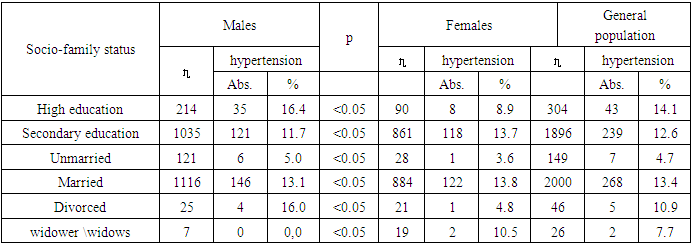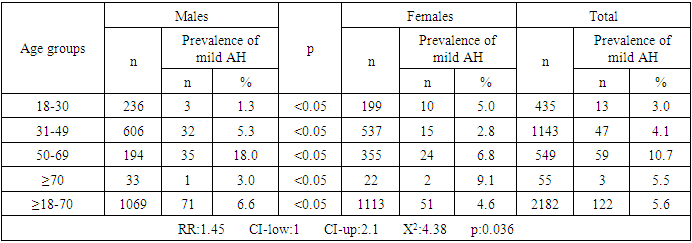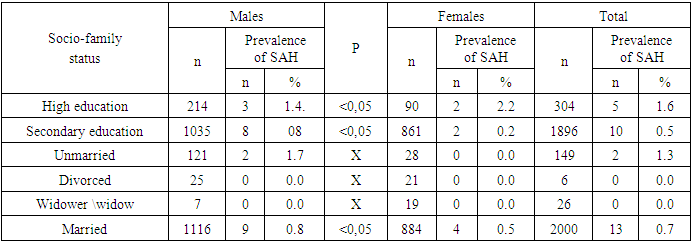-
Paper Information
- Next Paper
- Previous Paper
- Paper Submission
-
Journal Information
- About This Journal
- Editorial Board
- Current Issue
- Archive
- Author Guidelines
- Contact Us
American Journal of Medicine and Medical Sciences
p-ISSN: 2165-901X e-ISSN: 2165-9036
2022; 12(12): 1251-1255
doi:10.5923/j.ajmms.20221212.17
Received: Nov. 20, 2022; Accepted: Dec. 8, 2022; Published: Dec. 14, 2022

Epidemiology of Arterial Hypertension among the Population Engaged in Farming Activities
Mamasoliev Neymatjon Solievich, Nishanova Nadirakhon Akramovna, Tursunov Khatam Khasanboevich, Usmanov Burkhonjon Umarovich
Andijan State Medical Institute, Uzbekistan
Copyright © 2022 The Author(s). Published by Scientific & Academic Publishing.
This work is licensed under the Creative Commons Attribution International License (CC BY).
http://creativecommons.org/licenses/by/4.0/

The aim of the research was to study the epidemiological and preventive aspects of arterial hypertension among the population engaged in farming activities. Introduction. There is currently no epidemiological and preventive solution to the problem of arterial hypertension among the population engaged in farming activities. Material and methods. The object of the study was 2,182 people (1,069 men and 1,113 women aged ≥ 18-70) engaged in farming in the Pakhtaabad district of Andijan region in Uzbekistan. The study was conducted in 3 stages, according to the developed algorithm. Statistical processing was carried out according to the programs Epi Info, R Microsoft office 2021. Results. In the population engaged in farming activities arterial hypertension was determined with a frequency of 12.9%. Prevalence of arterial hypertension (frequency of spread) depending on family and social status: there was an increase in arterial hypertension by 3.5 times (P0.01), and the risk of arterial hypertension frequency was increased by 11 times from the age of 50 (P0.001). Discussion. In females under 30 and after 70 years of age, a mild degree of arterial hypertension was confirmed with a higher frequency than in males - 3.7 and 6.1, respectively. Moderate arterial hypertension was detected with a difference of 16.4%, i.e. by influencing family and social factors, this degree of arterial hypertension can be eliminated. Severe arterial hypertension was characterized by a low prevalence (1.0% in males and 0.4% in females). It was proved that isolated systolic arterial hypertension in ≥18-70-year-old farmers was observed with a frequency of 2.7%. Conclusion. The conducted research contributed to the creation of a differentiated preventive program and ensured not only the prevention of the disease, but also the improvement of treatment results, as well as the reduction of risk factors in the future.
Keywords: Arterial hypertension, Risk factors, Population engaged in farming, Dyslipidemia, Systolic blood pressure, Diastolic blood pressure
Cite this paper: Mamasoliev Neymatjon Solievich, Nishanova Nadirakhon Akramovna, Tursunov Khatam Khasanboevich, Usmanov Burkhonjon Umarovich, Epidemiology of Arterial Hypertension among the Population Engaged in Farming Activities, American Journal of Medicine and Medical Sciences, Vol. 12 No. 12, 2022, pp. 1251-1255. doi: 10.5923/j.ajmms.20221212.17.
1. Introduction
- Arterial hypertension is a multifactorial life-threatening disease of the cardiovascular system, which has an impact as a "silent killer" [1]. Therefore, consistent measures are being taken all over the world, including in Uzbekistan, to prevent, treat and control chronic non-communicable diseases (NCDs), their risk factors, reduce morbidity and early mortality of the population. In particular, Uzbekistan has adopted a concept for the prevention of NCDs for 2019 – 2022. Currently, world science recommends the creation of a preventive cardiology system as an effective way to combat NCDs, primarily arterial hypertension (AH) and its risk factors [2-3]. Strengthening the prevention of arterial hypertension (AH) has become an urgent need and necessity of modern science, according to the analysis of the results of 123 studies of 600 thousand people; annually 7.5 million deaths in the world are caused by arterial hypertension, which makes up 12.8% of all deaths; a decrease in systolic blood pressure (SBP) by 10 mm reduces the risk of heart failure by 28%, stroke - by 27% and total mortality - by 13%; however, 50% of patients stop taking drugs in the first year of treatment [1]. Cardiovascular diseases (CVDs), in particular, the reduction of morbidity, disability and mortality from arterial hypertension among the population remain an urgent public health problem. In most cases, CVDs end by lethal outcome (up to 60%), and in addition, there is a process of rejuvenation of diseases. According to the results of the investigation, hypertension, which has been dubbed the “silent killer”, remains the leading cause of the threat to life [4]. On an international scale, it is recommended to conduct regular epidemiological surveys, questionnaires on chronic non-communicable diseases (NCDs) and their risk factors based on recognized world methods [2].Therefore, the study and evaluation of these issues of the modern population has scientific and practical significance. Especially noteworthy is the lack of epidemiological and preventive solutions to the problems of arterial hypertension (AH) among the population engaged in farming. No preventive programs have been developed for the population engaged in farming activities in the conditions of Uzbekistan. The aim of the research was to study the epidemiological and preventive aspects of arterial hypertension among the population engaged in farming activities.
2. Material and Methods
- The object of the study was 2,182 people (1,069 men and 1,113 women aged ≥ 18-70) engaged in farming activities in the Pakhtaabad district of the Andijan region of the Ferghana Valley of Uzbekistan. The study was conducted in 3 stages: preparation for an epidemiological study (stage I), conducting a study (stage II) and analyzing the results obtained (stage III), survey methods, biochemical and instrumental research methods were used. The criteria of the Society of Cardiologists of Russia (2020) and Europe (ESC, 2018) were used in the assessment and determination of AH. When assessing the risk factors of the farmer population (dyslipidemia (DLP), alcohol consumption, smoking (cigarettes or nasvai), hyperglycemia, changes in trophic status, inactivity, eating fruits and vegetables in small quantities and assessing comorbidity, the experience of Russia (Countrywide integrated Noncommunicable Disease Intervention Program - CINDI) and recommendations of scientific societies of cardiologists of Russia and Europe (2018, 2020), World Health Organization (WHO) (2020) were used. The Epi Info, R Microsoft office 2021 programs were used for statistical processing of the received information.
3. Results
- The main features of the population consist of its geographical, professional, social, family and gender differences. The epidemiological details of hypertension among the population engaged in farming activities have been studied and evaluated taking into account these features. In general, AH is determined by the frequency of distribution of 12.9% in a population engaged in farming activities. (Tab. 1).
|
|
|
|
|
|
4. Discussion
- The study found that, depending on family and social status, there was a 3.5-times increase in arterial hypertension in the population engaged in farming (Р<0.01), and the influence of these factors was stronger in men than in women. The relatively high frequency of AH distribution was confirmed in people engaged in farming activity with high education and in married. These data absolutely confirm similar results obtained from other populations [4,2].The prevalence of hypertension in men and women, depending on age, is expressed as follows: in 18-30-years-old patients 3.8 and 10.6%, in 31-49–years-old 11.2 and 10.2%, in 50-69-years-old 34.0 and 11.8%, ≥ in 70-years-old 39.4 and 36.4% (Р<0.05). It follows from this that in women, the effect of age on hypertension was noticeable only in 18-30-years-old, in all men ≥ 31-7 years of age, it was reliably confirmed. For example, the frequency of detection of hypertension in men, depending on age, was increased by 13 times and in women - by 3.6 times (Р<0.01). Features of the revealed frequency of AH prevalence among the population engaged in farming activities contribute to the creation of a differentiated preventive program. When comparing physical labor with other risk factors, their “sanogenicity” is confirmed [5-7]. Therefore, among the population engaged in farming activities, aspects of the spread of a mild form of AH (blood pressure (BP) 140-159 and diastolic blood pressure (DBP) was 90-99 mm Hg), moderate AH (MAH) (systolic blood pressure (SBP) 160-179 and DBP 100-109 mmHg) and severe AH (SBP - ≥180 and DBP ≥110 mmHg). Socio-family influences were detected in a mild form of hypertension with a difference of 4.0%. The frequency of the spread was confirmed in the studied population with “high education” (12.2%); in “divorced” the frequency of detection was relatively lower (8.7%), in “widows” (7.7%), in “married” (6.2%) and “with secondary education” (5.0); in “married” - low indicator (1.3%).A mild form of hypertension was observed in men with a noticeably higher frequency and was confirmed by a 2.6-fold increase in the total number of the farm population, depending on age. In addition, attention should be paid to another conclusion: in women under 30 and after 70 years, mild hypertension was confirmed with a higher frequency than in men - 3.7 and 6.1; in other age groups, the frequency of its detection “prevailed" in men. Depending on risk factors, the prevalence of moderate severe hypertension in the general population was detected with a difference of 16.4%, in women – 30.0% and in men - 10.7%. This means that by influencing family and social factors, moderate severe hypertension can be eliminated by at least 16.4% in the population engaged in farming activities. The frequency of moderate severe hypertension detection in men and women of different age groups was characterized by the following indicators: in 18-30-years-old – 1.7 and 5.5% (P<0.05), in 31-49-years-old - 5.1 and 7.3% (P<0.05), in 50-69-years-old - 13.9 and 4.2% (P<0.05) and in ≥70-years-old - 12.1 and 22.7% (P=0.056). Moderate severe hypertension was observed with a frequency of more than 1.0% often than mild hypertension.In general, hypertension was expressed in a low prevalence in the farming population and its severe form was confirmed, not exceeding 1.0% (in males) and 0.4% (in females). We think that in this case this is due to the high physical activity of the population. It should be noted that the peculiarity of nutrition (fruits and vegetables, the use of milk and dairy products) may be a factor protecting them from AH.
5. Conclusions
- The obtained results confirm that the age factor is a strong factor of AH. In each group of the population engaged in farming, the risk of developing and increasing the frequency of hypertension increases 11 times from the age of 50 (Р<0.001). In this type of population, the fight against hypertension not only ensures the prevention of the disease, but also contributes to improving the treatment results of the cardiovascular system diseases and non-communicable diseases and reducing their risk factors in the future. The data obtained can be of great importance in strengthening measures in the fight against hypertension and the development of control programs as a “tool”. It should be noted that arterial hypertension and all its types detected in the population engaged in farming with low percent indicators should not remain an “invisible” object of preventive medicine. There is no doubt that this epidemiological analysis is effective and useful.The authors declare no conflict of interest. This study does not include the involvement of any budgetary, grant or other funds. The article is published for the first time and is part of a scientific work.
 Abstract
Abstract Reference
Reference Full-Text PDF
Full-Text PDF Full-text HTML
Full-text HTML




